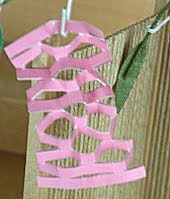

July 7th is the day of Tanabata(七夕) or the Star Festival.
According to a Chinese legend, the two lovers(stars) of the Weaver (Vega) and the Cowherd (Altair) can only meet across the Milky Way once a year on the night of Tanabata, the 7th day of the 7th month in the lunar calendar.
Kikkouden(乞巧奠) was an event that people wished to improve their skill of sewing, playing music and writing like Vega who was an accomplished weaver. It was held at the imperial court in the Nara Period or the Heian Period.
In the Edo Period, it was positioned as one of the five season-related celebrations, annual events for samurai class.
It is said that Tanabata is a synthesis of the Chinese legend, Kikkouden and another Japanese purification ceremony.
Pieces of bamboo were set up in the garden and adorned with strips of paper of five different colors on which were written poems, and food were offered. On the following day, the bamboo and the strips of paper were floated down rivers to wash away bad luck. Bamboos were believed to possess the power to ward off evil.
In the solar calendar, the festival fell during the rainy season. It's raining now.
The Star Festival in Hiratsuka is held in July, but the festival in Sendai is held in August according to the lunar calendar.

On the tatami mats, there are strips of paper and a writing box including suzuri(硯,ink stone), fude(筆,ink brush), sumi(墨,inkstick) and suiteki(水滴,small water jug).
Recently, syodo performance(書道パフォーマンス) is attracting an attention. It is the team competition that some members of a high school calligraphy club draw characters on a huge Japanese writing paper with huge ink brushes and sumi, dancing in tune with the music.
Some calligraphers are alarmed by flashy performances to attract a lot of attention, but most give favorable reviews that using their bodies to draw characters leads to improve their skills.
As an aside, Samuel Kamau Wanjiru, who won the gold medal in the men's marathon at the 2008 Beijing Olympics Games, won a prize at a Japanese calligraphy exhibition for high school students while studying at Sendai Ikuei Gakuen High School in Japan.

Biwa(琵琶,Japanese lute) is a musical instrument which has the same root with lute. We associate biwa with "The Tale of the Heike(平家物語)" or "Houichi without Ears (耳なし芳一)".

Hanging scroll with a painting of the Weaver and the Cowherd is placed in the alcove.
typical Tanabata ornaments

●strips of paper(短冊,tanzaku) to improve people's learning and writing.
Now many people write their wishes on strips of colorful paper and hang them from bamboo branches.

●cast net(投網,toami) to pray for a bumper catch

●streamers(吹流し,fukunagashi) represent weaving yarns of the Weaver
●paper garment(紙衣,kamigoromo) to transfer people's misfortune and disease onto, or to improve people's sewing
●folded-paper crane(折鶴,orizuru) to pray for a long life
●drawstring bag(巾着,kinchaku) to save money by economizing
●garbage box(屑籠,kuzukago) to take care of what one has and keep a clean house

Edamame(枝豆,green soybean) & beer, cold tofu(冷奴,hiya-yakko) and Japanese vermicelli(素麺,soumen) are staple dishes in summer.
Soumen and ice cubes are in the round wooden tub with water.
Floating maple leaves create the sensation of coolness.
People had a custom of eating soumen of five different colors in the Imperial court on the day of Tanabara.
We often eat cold noodles in summer such as soumen, cold soba noodles with dipping sauce and chilled Chinese noodles. Soba noodles can also be served warm or chilled. Cold pasta dishes are also served at restaurants in summer.
A postcard for a summer greeting is sitting on the low dining table.
We used to have a custom to write to friends and acquaintances offering best wishes for the hot season, but less people do it now.
an electric fan of old sort and screen windows to let the wind in and keep the bugs out.

A legless chair with a rattan seat and a rattan pillow for summer.
Morning glories are blooming in the garden.
No comments:
Post a Comment